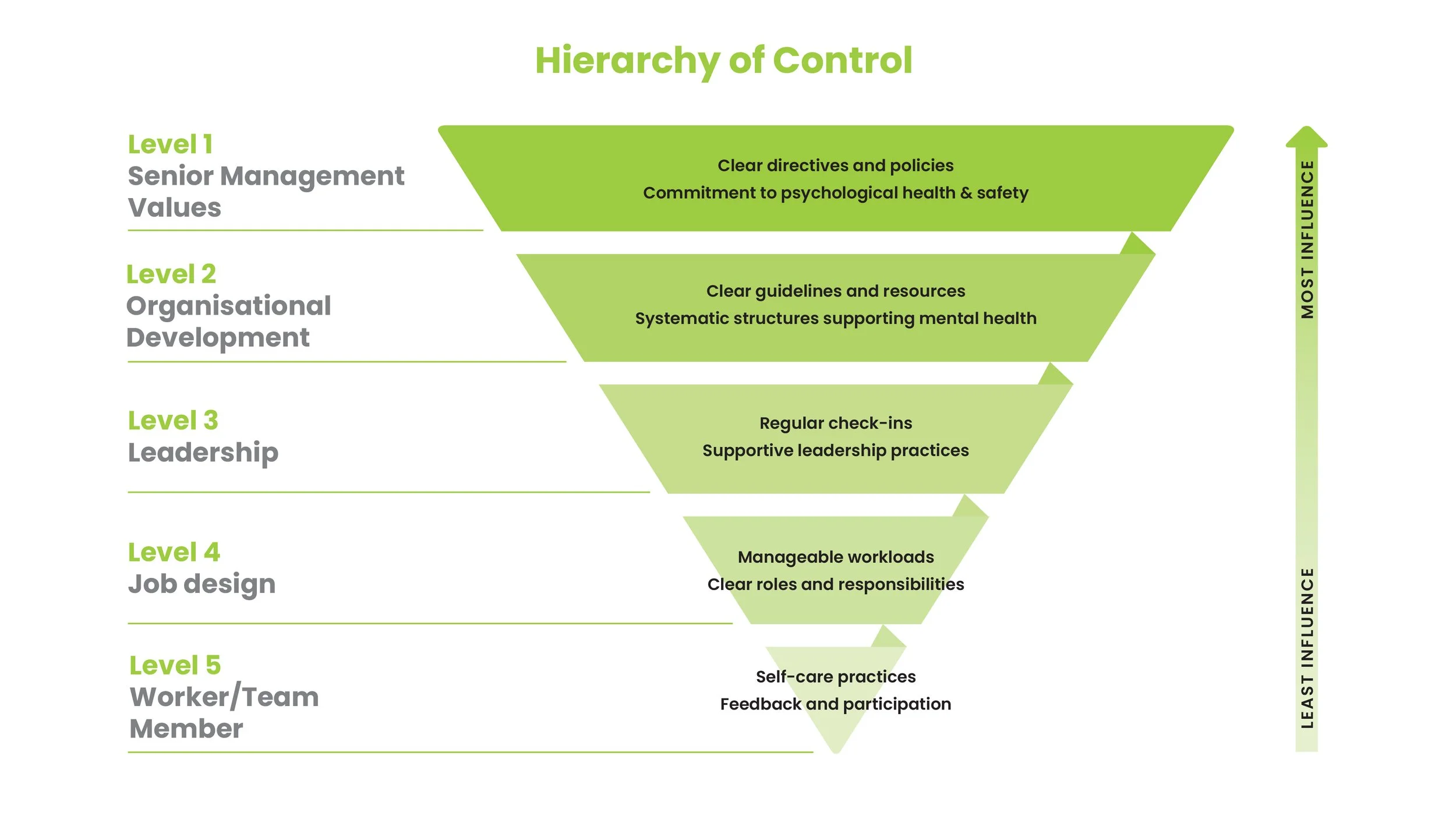For too long, organisations have relied on resilience training and wellbeing apps to tackle workplace stress. But these efforts only scratch the surface. When the root causes – like poor job design, unsupportive leadership, and excessive workloads – go unaddressed, burnout and disengagement persist. The real question isn’t how can employees cope better? but how can we create workplaces where people don’t have to just cope?
In this two-part series, Dr Chanvi Singh explores the Psychosocial Safety Climate Hierarchy of Control (PSC-HOC) framework, a research-backed model that helps organisations build psychologically healthy workplaces.
In Part 1, we break down the five levels of the framework, from senior leadership commitment to individual worker strategies. Then, in Part 2, we’ll look at what it takes to put this model into action – practical steps to move beyond quick fixes and create meaningful, lasting change.
“Just be more resilient” – it’s the workplace equivalent of telling someone to “just cheer up” when they’re feeling down. Yet this approach to workplace wellbeing remains startlingly common. The good news? Forward-thinking organisations are finally moving beyond this outdated mindset toward more effective, evidence-based frameworks that recognise wellbeing as a shared responsibility.
The Limitations of Individual Resilience
In my work bridging research and practice, I frequently encounter organisations proud of their wellness initiatives – the resilience workshops, the EAP programmes, the wellbeing apps. When I ask about their approach to job design, leadership capability, or organisational systems that impact psychological health, the conversation often grinds to a halt.
The message we’ve been sending employees is clear but problematic: “The work environment is challenging, so we’ll help you cope better with it.” What if instead we asked: “How might we design work environments where people naturally thrive?”
This shift from individual resilience to systemic responsibility, represents the future of workplace wellbeing.
A Systems Approach to Psychological Health
To create truly psychologically healthy workplaces, we need frameworks that recognise wellbeing as an outcome of organisational systems, not just individual choices. This is where the Psychosocial Safety Climate Hierarchy of Control (PSC-HOC) framework offers powerful guidance.
Developed by Professor Maureen Dollard and Dr. Tessa Bailey* – This evidence-based model provides a structured approach to enhancing worker psychological health by targeting interventions at multiple organisational levels.
The Psychosocial Safety Climate Hierarchy of Control
The PSC-HOC framework adapts the traditional safety hierarchy of control to specifically address psychosocial risks. It recognises that effectiveness increases as we move up the hierarchy, with the greatest impact coming from senior leadership and systemic interventions.

Bailey, T. S., & Dollard, M. F. (2014). Psychosocial hazard management and the Psychosocial Safety Climate Hierarchy of Control (PSC-HOC). In The Australian Workplace Barometer. Australian Academic Press.
Here’s how the hierarchy works, from most to least effective:
Level 1: Senior Management Values & Commitment
This level represents the foundation of psychosocial safety – genuine commitment from senior leadership that translates into concrete policies, resource allocation, and visible prioritisation of psychological wellbeing.
Level 2: Organisational Development & Systems
At this level, HR teams and workplace specialists build the infrastructure to support psychological health – reporting mechanisms, communication channels, and integration of wellbeing into core business processes.
Level 3: Leadership Capability & Behaviour
Middle managers and team leaders translate organisational commitment into daily reality. Their capability to recognise psychological risk, have effective wellbeing conversations, and model healthy work practices shapes team experiences.
Level 4: Job Design & Work Environment
This level examines how work itself is structured – workloads, role clarity, autonomy, and recognition systems all directly impact psychological health.
Level 5: Individual Worker Strategies
At the foundation sits individual responsibility and capability – personal boundary-setting, recovery practices, and self-care strategies.
Understanding the PSC-HOC framework is just the first step. The real challenge is turning these insights into action.
In Part 2, we’ll cover how to assess your organisation’s current state, secure leadership buy-in, and implement strategies that make a real difference to employee wellbeing.
Stay tuned for Part 2 where we explore practical steps for making the shift.
Dr. Chanvi Singh is a practitioner-academic (pracademic) in Work and Organisational Psychology, specialising in translating complex theories into practical workplace solutions for the evolving future of work. Her expertise spans organisational culture, leadership development, workplace innovation, and evidence-based change management.




